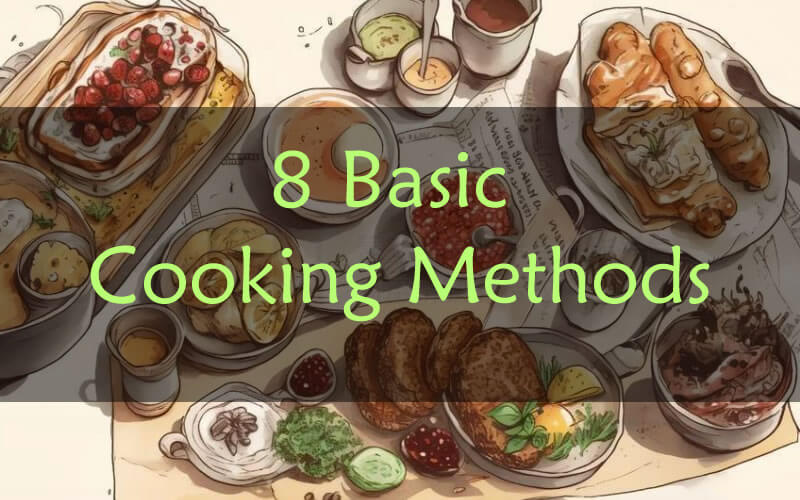8 Basic Cooking Methods
The proper cooking methods for different meals are determined by their qualities and types. Here are some broad recommendations:
Meat: To kill bacteria, ensure that meat is cooked to the proper internal temperature. Check the doneness of the meat with a thermometer.
Fish: To keep fish from becoming too dry, avoid overcooking it. Grilling, steaming, and pan-frying are all options.
Vegetables: To keep nutritious value, use gentle cooking methods such as steaming or fast stir-frying.
Fruits: While most fruits can be consumed raw, they can also be used in salads, juices, and jams.
Grains and Pasta: Cooking times for grains and pasta should be observed to ensure that they are easily digestible. To prevent sticking, stir the pasta frequently while it is cooking.
Dairy Products: Ensure that raw dairy products are maintained at the right temperature to prevent bacterial growth.
To reduce the risk of foodborne illness, make sure eggs are thoroughly boiled.
Following food safety requirements, cooking at the proper times, and using clean cooking equipment and materials are all important factors in maintaining the safety and enjoyment of diverse cuisines.

Common Cooking Methods
Bake or Roast
Roasting takes a little longer than other ways, but it involves very little effort on your part. Roasting is an option for poultry and tender portions of meat. Cook uncovered on a rack in a small roasting pan in the oven to drain fat and allow heat to circulate around the meat. Bake potatoes, sweet potatoes, winter squashes, and onions. Simply wash the vegetables, puncture the skins, and arrange them on a baking tray in the oven.
Barbecue
Roasting dishes over coals on a rack or spit is a pleasant, low-fat way to prepare meat, chicken, fish, and vegetables. Foods that have been barbecued have a characteristic smokey flavor. Trim fat off meat to prevent flames from igniting and to save calories. If you want to season with sauce, make your own with less salt, sugar, and fat.
Braise
Braising is primarily used for meats that require longer cooking times to get tender. Braised root veggies are also delicious. Brown the meat in a tiny quantity of oil or its own fat, then simmer in a covered skillet with a little liquid. For extra flavor, consider using fruit juice, cider, wine, broth, or a mix of these.
Broil
Broiling is a quick way to cook dishes over direct heat without adding fat. It works well with poultry, fish, and tender cuts of meat. To drain fat, use a broiling pan or a rack positioned in a shallow pan. For flavor, use lemon juice, fruit juice, or both when basting. Broiled vegetables include onions, zucchini, and tomatoes.
Broiling or stewing
In these low-fat, low-salt cooking methods, foods are cooked in hot liquids. The liquid that remains after cooking can be used to make a wonderful broth, the base of a sauce, or it can be served alongside the cuisine. If storing sauce separately for later use, cool the liquid first and skim off any fat that rises to the surface. Broiled potatoes, corn on the cob, lima beans, and turnips are examples of starchy or root vegetables.
Microwave
Food cooks faster in the microwave than in most other techniques. There is no need to add fat to meat, poultry, or fish, and veggies require little to no water. Microwaving veggies is a fantastic technique to keep their vitamins and color. Water soluble vitamins and minerals are lost when foods are cooked in water and the water is then discarded.
Sfirfry
Stirfrying is quick and easy, uses minimal fat, and keeps the crispness and color of veggies. Heat a wok or heavy skillet over medium heat, add just enough oil to coat the bottom of the pan, add the meal, and stir regularly while cooking.
Start with thin strips or chopped chunks of meat, fowl, or fish if using meat. Add small pieces of equally chopped vegetables such as onions, broccoli, cauliflower, zucchini, sprouts, carrots, green peppers, and mushrooms when the meat is almost done. Serve with a low-salt "sweat & sour" sauce or soy sauce on the side.
Steam
For more information, see: 8 reasons why I choice steamed food.
Steaming is a healthy technique to cook vegetables without adding fat. This method works well with frozen and fresh veggies like asparagus, broccoli, carrots, spinach, and summer squash. set vegetables in a vegetable steamer or colander, set in a pot with a little boiling water, and cover. To keep the color and nutrition, cook the vegetables until they are just soft.